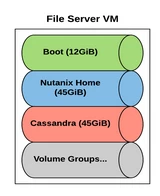This content is taken from Nutanix File Solution doc available on the portal. I am just reposting this content here. 🙂 Happy Learning
Please refer the solution doc for more details
https://portal.nutanix.com/#/page/solutions/details?targetId=TN-2041-Nutanix-Files:TN-2041-Nutanix-Files
As shown in the following figure, each FSVM uses three separate vDisks: a 12 GiB boot disk that contains the boot image, a 45 GiB disk (/home/nutanix) that contains logs and software state, and a 45 GiB disk for Cassandra data.
A Nutanix Files cluster is a single namespace that includes a collection of file systems used to support the SMB and NFS shares. These file systems use Nutanix volume groups as storage. Volume groups enable both high availability and scale-out for the file systems. A volume group is a collection of logically related vDisks (or volumes) attached to the guest via iSCSI. When an FSVM is down for maintenance or if a fault occurs, one of the surviving FSVMs takes over volume group ownership and continues servicing requests.
With the 2.x release of Nutanix Files, volume groups contain six virtual disks: two disks used for metadata and four disks used for data. The four data disks represent 40 TB of available storage for a given share using that volume group.
With the 3.x release of Nutanix Files, volume groups contain 16 virtual disks. Files 3.x versions prior to version 3.2 use 2 disks for metadata and 4 disks for data, as in the 2.x release, with the remaining disks reserved for expansion in later versions. From the 3.2 release of Files onward, all disks in the volume group are available for use by the assigned shares, representing a maximum standard share size of 140 TB.
The initial file system pool created on the volume group uses six of the drives as previously noted and supports 40 TB of data.
Once this file system pool reaches 80 percent space utilization, Nutanix Files automatically expands it to 80 TB by incorporating another four data disks from the volume group.
This expansion process can occur two more times, increasing the file system capacity to 120 TB with the second expansion and 140 TB with the final expansion. Each expansion is triggered at 80 percent space utilization of the current pool.
Enter your E-mail address. We'll send you an e-mail with instructions to reset your password.





